Microsoft Surface Go 3 Review
Microsoft's latest tablet is a disappointment
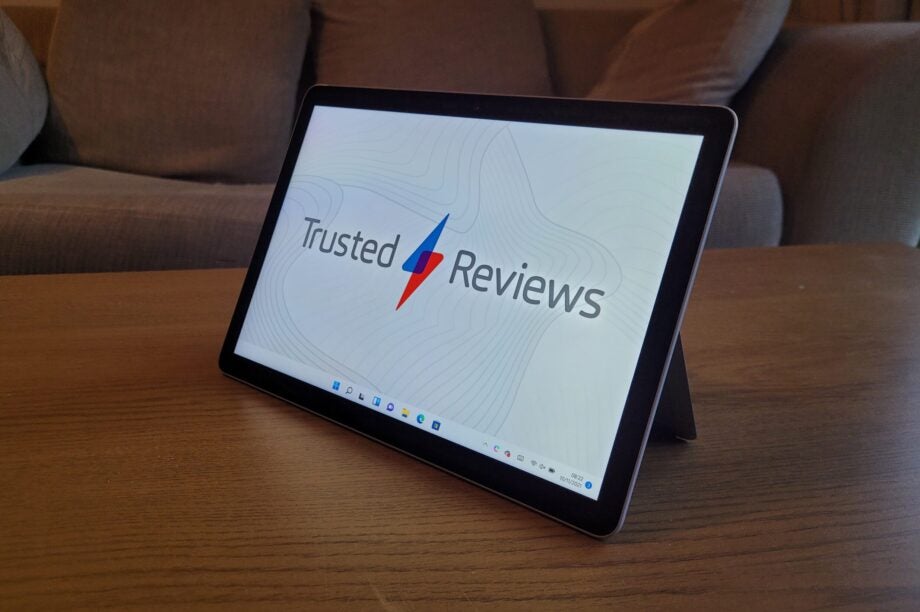
Verdict
The Surface Go 3 hasn’t changed all that much since the previous model, with a splash of new Windows 11 operating system goodness and a processor upgrade being the key differentiators. Unfortunately, that’s not quite good enough when up against stiff competition like Apple’s iPad. It’s a tough sell, given below-par battery life and middling specs.
Pros
- Boosted performance
- Windows 11 improves the tablet experience
- Great design, with built-in stand
Cons
- Minor improvements compared to Surface Go 2
- Poor battery life
- Type Cover costs extra
- iPad is faster and has a better screen
Availability
- UKRRP: £369
- USARRP: $399.99
Key Features
- Improved CPU performance:Microsoft has upgraded the CPU for the Surface Go 3, boosting the performance compared to its predecessor.
- Pre-installed with Windows 11:Windows 11 enhances the tablet experience with a more touch-friendly navigation and an improved app store.
- Compatible with Type Cover:The Surface Go 3 can be connected to a detachable keyboard, turning into a makeshift laptop, but you’ll need to pay extra for this accessory.
Introduction
The Surface Go 3 is the latest version of Microsoft’s small tablet. It’s a super-compact hybrid machine, owing to a Type Cover, that must be bought separately. The size makes it appealing as a run-of-the-mill tablet, with keyboard combo making it a functional, if small, laptop-like device.
The Surface Go range has always been an intriguing proposition, providing a ton of portability alongside the ability to get some worked done. That is, if you don’t mind things being a little cramped. This latest model continues the trend, with some small updates.
Standing still may have put the Surface Go 3 further behind though. It has strong competition in the form of Apple’s iPad and the Lenovo Chromebook Duet. Microsoft’s latest budget tablet looks like it will struggle to complete, despite the additions of Windows 11 and a more powerful CPU making it a slightly improved experience compared to the Surface Go 2. If you do need extra power, the Surface Pro 9 is now available too.
Design
- No changes to design since Surface Go 2
- Type Cover still costs extra
- Great build quality, and built-in stand
The Surface Go 3 has the exact same design as its predecessor. Even if you whip your ruler out and start meticulously measuring every edge, you’ll realise the dimensions are unchanged at just 8.3mm thick.
I personally don’t think this is an issue, as the new device both looks and feels great, with a metal build and a Corning Gorilla Glass 3 screen boasting a far higher quality than say the cheaper Amazon Fire tablets.
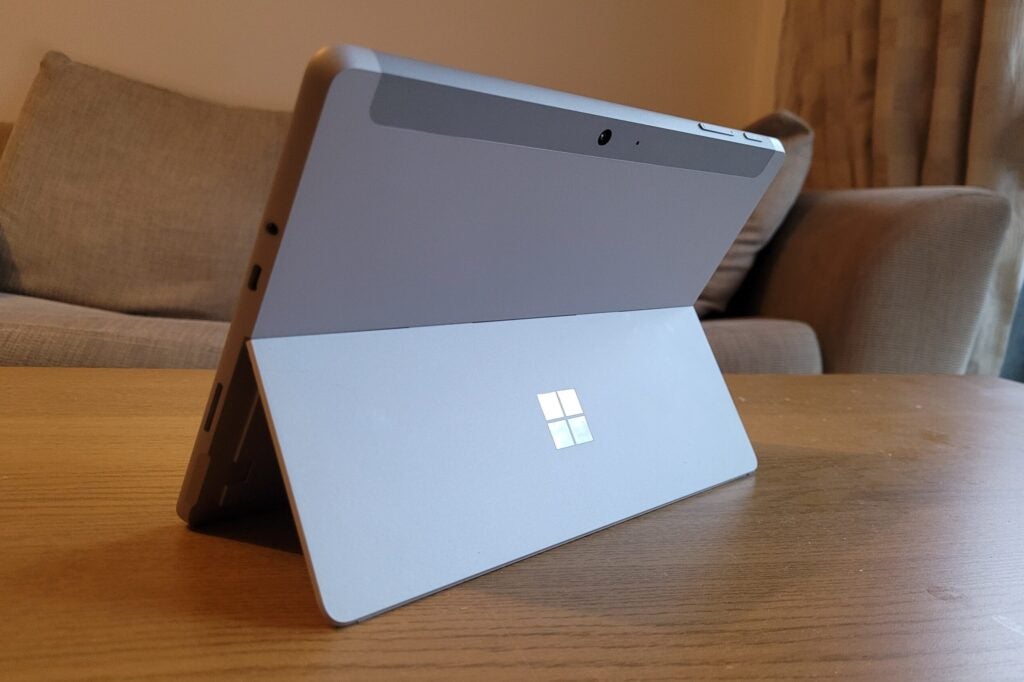
The built-in stand is one of my favourite aspects of the Surface Go range, allowing you to prop it up on a table without the need for a separate accessory. The stand feels study too, so should easily withstand the bumps of a train journey.
It’s unfortunate that Microsoft doesn’t bundle the Type Cover with the Go, which costs a whopping £99 – or an even more costly £124.99 if you want an Ice Blue, Platinum or Poppy Red variation. It’s a similar story with Apple’s iPad, but the Lenovo Chromebook Duet is worth checking out if you want everything bundled together at default.
The Surface Go Type Cover feels fine. It magnetically clips to the tablet’s underside, as well as the bottom bezel to create a comfortable slant. But the keys are rather shallow, and the keyboard’s deck is noticeably flimsy, causing the Type Cover to bounce up and down as you hammer at the keys.
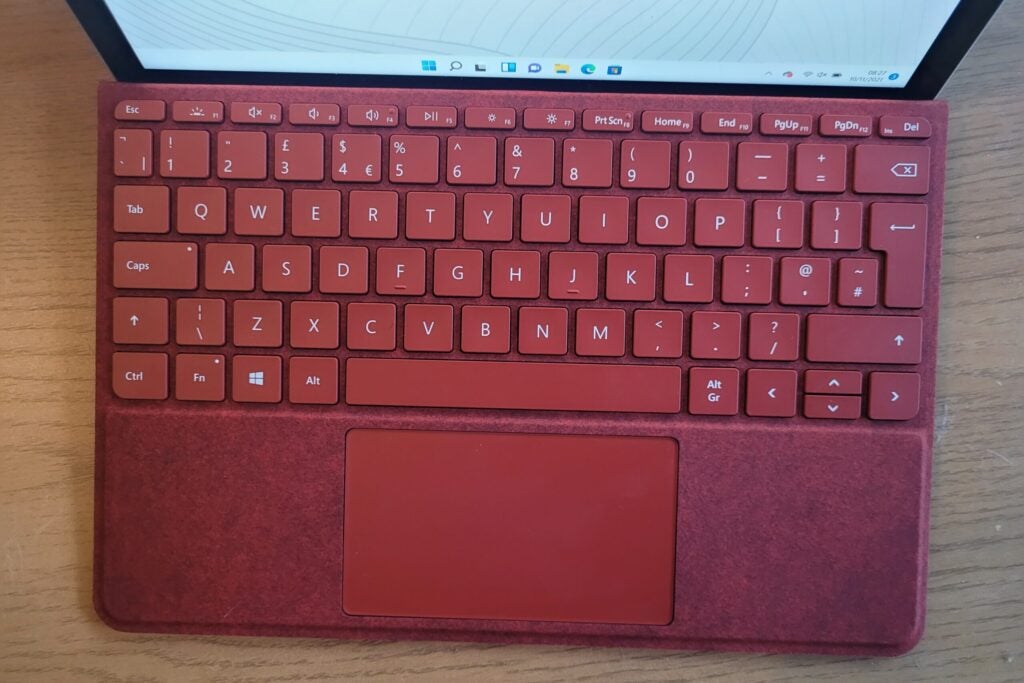
It’s fine for the likes of web browsing, writing emails or even completing short bursts of homework, but those who need to write lots and lots of copy will likely want a proper keyboard instead.
You’ll find a few ports on the device’s edge, including USB-C, a MicroSDXC card reader, 3.5mm headphone jack and the Surface Connect port for power delivery. I’d personally like to have at least one additional USB-C port, but can understand why Microsoft hasn’t been able to squeeze a USB-A onto its slender frame.
There’s also a 1080p webcam above the screen, which captures surprisingly decent video, at least for the likes of Microsoft Teams and Zoom. It even supports Windows Hello for facial recognition logins. A rear-facing 1080p camera can also be found around the back of the device, although it’s nowhere near the standard of flagship smartphone sensors, so I don’t recommend using it for your holiday snaps.
Display
- Full HD display is ideal for watching video
- Has great contrast and a good range of colours
- iPad boats superior specs and costs less
I’ve got no complaints about the 10.5-inch screen. The 1920 x 1280 resolution is plenty sharp enough for a tablet this size, and it presents video with plenty of brightness and colour.
I enjoyed watching Netflix and the like on this tablet, proving to be a good device for portable watching. I was especially impressed to see how vivid the colours looked when watching cartoons such as SpongeBob SquarePants, making it ideal for children.
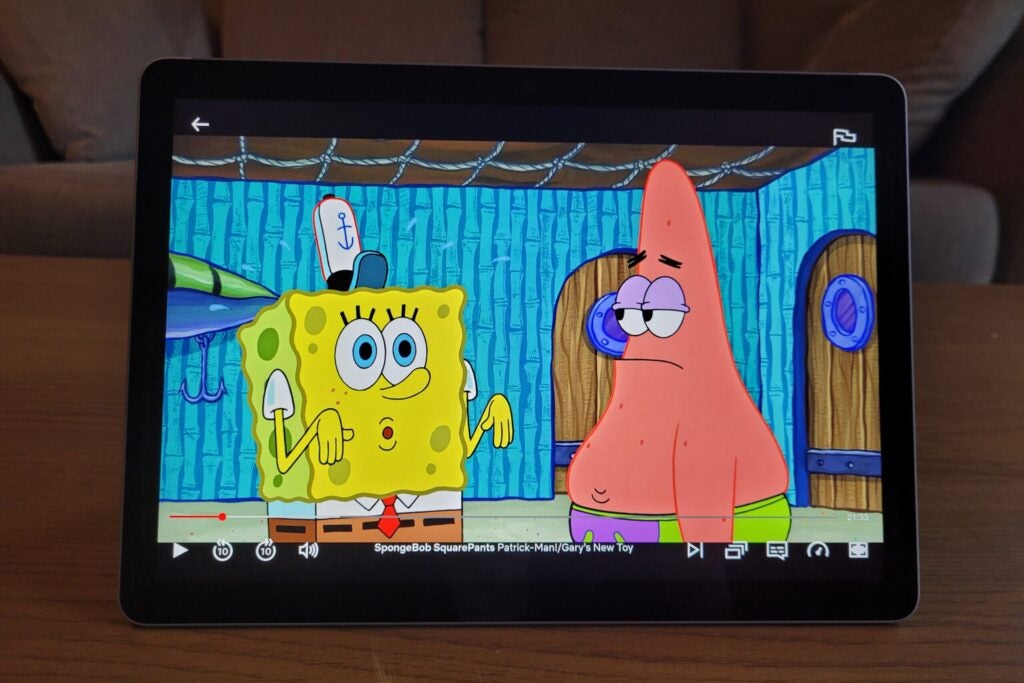
I used a colorimeter to test the performance of the screen, and the results backed up my first impressions. The 375-nit figure is easily bright enough for use outdoors, while the 1368:1 recorded contrast is better than most laptop or tablet screens at this price, resulting in a pleasant video experience.
Colour accuracy is high enough for watching video and creating digital art, although you’ll want a greater range of colours here for professional work – the Surface Go simply isn’t designed for such use cases.
But while I’m quietly pleased with the Surface Go 3’s display, it’s also worth knowing you can get better elsewhere. Apple’s entry-level iPad is not only cheaper but boasts a 10.2-inch screen with a 2160×1620 resolution and up to 500 nits of brightness. And the Surface Go 3 screen is no improvement on that of the £279.99 Lenovo Duet Chromebook either.
Performance
- Two processor options available
- High-end chip offers reasonable speeds
- Windows 11 improves the tablet experience
Performance is the only area Microsoft has significantly improved the Surface Go 3 compared to its predecessor. You now get the option of two chips: the dual-core Intel Pentium 6500Y (from £369) or the dual-core Intel Core i3-10100Y (from £569). Neither options are powerful enough to compete with a high-end laptop, but they’re adequate for a tablet.
Microsoft sent me a unit with an i3-10100Y chip, which is the most powerful you can currently get. The Surface Go 3 ran perfectly well with this chip, hopping from web page to web page without much delay. But don’t expect this tablet to power through taxing applications, as it’s designed for basic day-to-day tasks and little else.
The benchmark results show a sizable performance jump compared to the Surface Go 2, although that’s admittedly an unfair comparison since I’m using the results of the entry-level Surface Go 2 configuration. In Geekbench 5, the iPad (10th Generation) greatly outpaces the Surface Go 3 with its 3190 multi-core score thanks to the power of the Bionic A14 chip – it’s yet another area where Apple beats Microsoft.
Microsoft sadly hasn’t improved the storage capacity, with just 64GB eMMC and 128GB SSD options available. That really isn’t much storage space at all, so you’ll likely need to make a lot of use of cloud services in order to store all of your documents, photos and videos.
The Surface Go 3 comes with Windows 11 preinstalled, and the new operating system makes for a far better tablet experience than Windows 10. The centralised taskbar and a focus on icons and widgets (as opposed to claustrophobic menus) have all been designed with a touchscreen in mind. And the improved Windows 11 app store is also a big boon for those who want to use the Surface Go 3 like a traditional tablet.
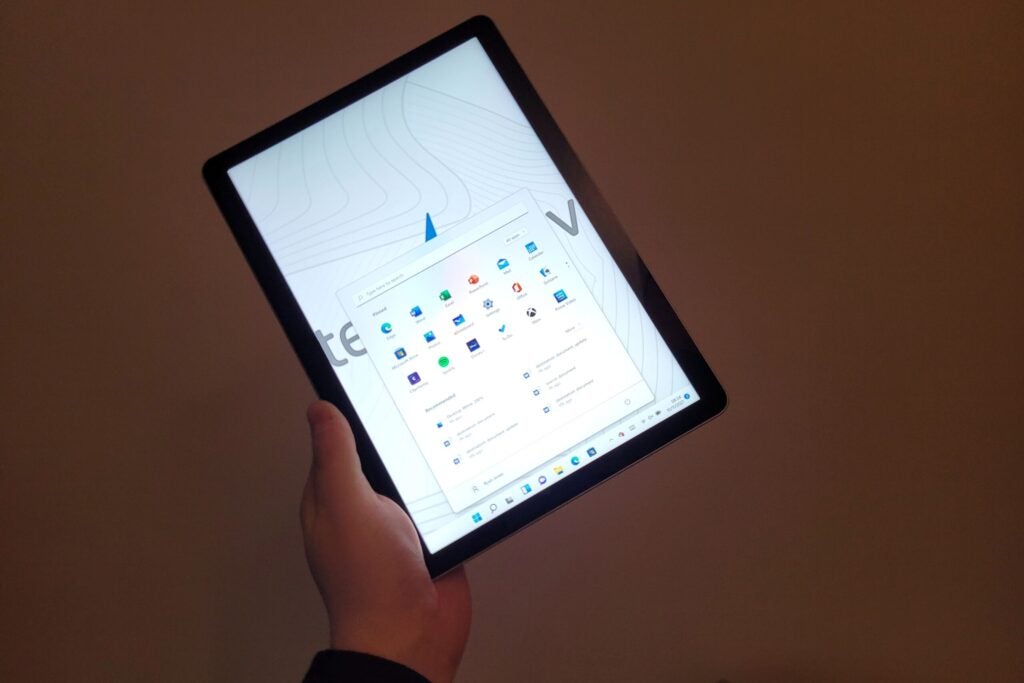
That all said, I still think Windows 11 lags behind the likes of iPadOS and ChromeOS for touchscreen use. The iPad simply offers a far more streamlined and user-friendly experience, with no extra fiddling required to get every home screen and app optimised for prods and swipes. The Surface Go 3 is arguably more intuitive when used with a keyboard and mouse, but you’re better off buying a Chromebook or mid-range Windows laptop if that’s going to be your main method of use.
It’s also worth pointing out that Windows 11 is available for free on any Windows laptop or tablet device, as long as it meets the system requirements. This means you can install Windows 11 on a Surface Go 2, so you’re not getting any benefits in terms of software by spending extra on the Surface Go 3.
Battery life
- Worse battery life than the Surface Go 2
- Lasted just 7 hours and 30 minutes in benchmark test
The upgrade to a new processor has actually come at a cost for Surface Go 3, as benchmark results suggest it actually has worse stamina than the Surface Go 2.
After turning the brightness down to 150 nits and running the PCMark 10 office battery benchmark, the Surface Go 3 lasted just 7 hours and 30 minutes before shutting down. For comparison, the Surface Go 2 lasted 9 hours and 13 minutes in the same test.
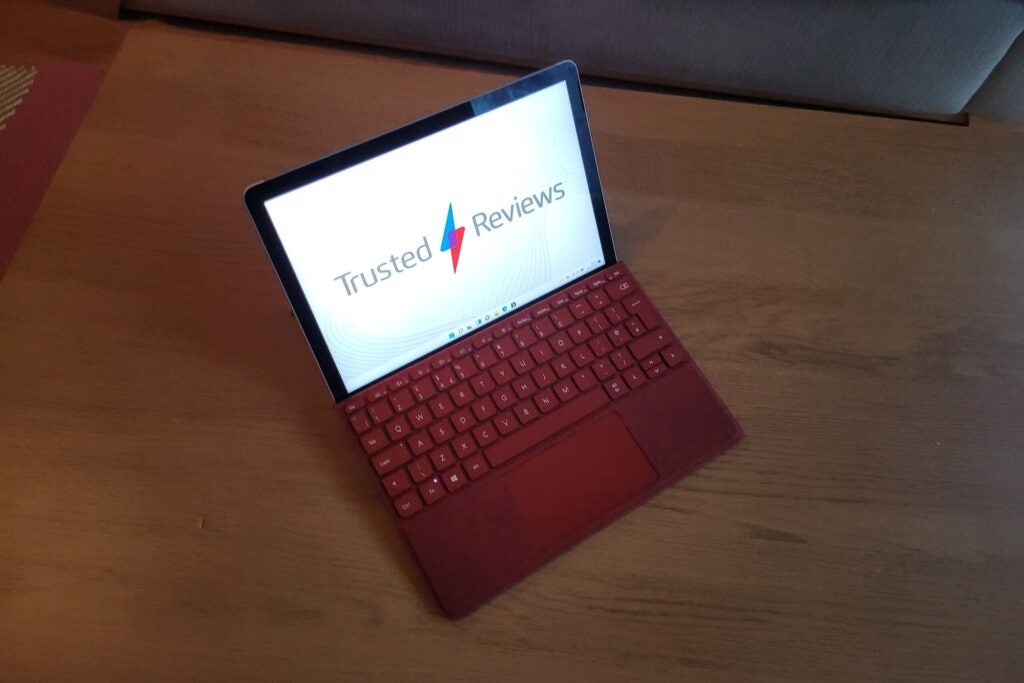
That’s a major issue, as the Surface Go 2 already had an average battery life compared to the competition. The iPad (9th Generation) lasted around 10 hours during testing, while the Lenovo Chromebook Duet was capable of a far more impressive 13-hour figure.
The Surface Go 3’s poor battery life also means that you may be better off sticking with the older Surface Go 2 instead, especially since it has been discounted this year and will likely feature in the Black Friday sales.
Latest deals
Should you buy it?
You want a Windows 11 tablet:
Windows 11 is a nice step up on Windows 10 for tablets, with more touch-friendly icons making it far easier to navigate. However, it’s worth pointing out that Windows 11 is available as an upgrade for the Surface Go 2 too.
You’re happy to go for an iPad or Chromebook:
The biggest issue with the Surface Go 3 is that it doesn’t offer up an advantage over the iPad, despite Apple’s tablet seeing a lower price. Lenovo’s Chromebook Duet also represents superior value by bundling in the detachable keyboard.
Final Thoughts
It’s hard not to be disappointed by the Surface Go 3. The only real improvement here compared to the Surface Go 2 is a speedier processor, but that’s also been offset by the shorter battery life.
This is still a good tablet, with a great design and lovely screen, but Apple’s iPad offers superior quality at a cheaper price, while the Lenovo Chromebook Duet represents far better value since it bundles in the keyboard attachment free of charge.
How we test
We test every tablet we review thoroughly. We use industry standard tests to compare features properly and we use the tablet as our main device over the review period. We’ll always tell you what we find and we never, ever, accept money to review a product.
Used as our main tablet during test period
Tested with synthetic benchmarks and real world use
Tested the battery life
FAQs
Yes, you’ll be able to use a wireless mouse since it features Bluetooth. Wired mice are a little more tricky, as there’s no USB-A port, but you can plug an adaptor into the USB-C port instead.
Yes, but only the latest USB-C standard. It does feature the old rectangle-shaped USB-A connection.
No, you’ll need to pay extra for the keyboard accessory, which has a starting price of £99.99.
Trusted Reviews test data
Full specs
Jargon buster
Refresh Rate
The number of times the screen refreshes itself per second.Nits
The brightness level of a display. 300 nits is regarded as the minimum target for high-end screens.








